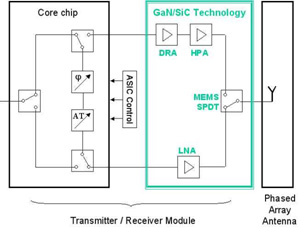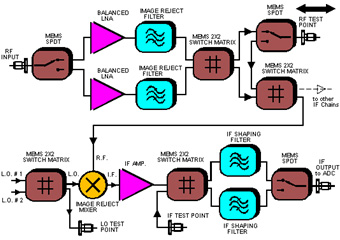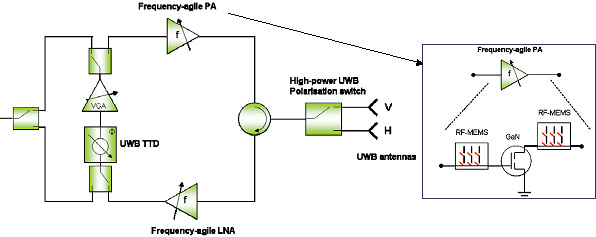GaN and RF-MEMS technologies for space T/R modules
The European Space Technology Platform mentioned in its last SRA a need to support non-dependence on critical technologies from outside Europe for future space applications. In particular, one action under bullet to reduce critical ITAR dependence is to secure access to high-performance microwave components used in satellite communication/navigation payloads, and earth observations/science instruments such as radars. Future satellite services will require novel types of microwave components to meet the demands in terms of more flexibility (ultra-wide-band UWB frequency allocation) and mass reduction. Two technologies are now emerging to face these challenges:
- Wide Band Gap (WBG) semiconductors such as GaN are expected to play a fundamental role in the development of Intelligent Micro Systems (IMS), yielding unprecedented power performance, efficiency and, along with suitable UWB re-configurable architectures.
- RF-MEMS switches as a complementary low-loss switch technology in order to achieve the re-configurability required for future IMS.
The route towards re-configurability of high power systems requires the merging of these key technologies and functions but they have not been co-integrated so far. Therefore, the main concept of SATURNE is to realize such novel types of microwave functions (re-configurable front-ends) using WBG MMICs integrated with RF-MEMS. The technological trends for transmit and receive front-end systems for many kinds of applications will be considered like:
- Re-configurable and highly power efficient communications satellite payloads with narrow-, multi- or wide-band channel allocation;
- Civilian space applications like environmental monitoring and cartography in X-band.
The SATURNE consortium is confident that the realization of its ambitious objectives will assist Europe to achieve technological leadership in domains that are targeted by ESA.
The main objectives of SATURNE are:
- To prove the feasibility and inherent advantages of using WBG and RF-MEMS based technologies in Intelligent Micro Systems for future space transmitting ultra wideband (UWB) receiving systems. This will be achieved via the integration (monolithic and hybrid) of WBG devices such as GaN based MMICs (LNA and HPA) and RF-MEMS switching networks for the realization of different active subsystems required for IMS.
- The GaN and RF-MEMS based circuits will be used to realize three types of very compact (small size and low weight) antenna breadboards for a proof-of-concept: (1) a smart active antenna made up of several Transmitter / Receiver (T/R) modules, (2) a miniaturized reconfigurable front-end and (3) a frequency-agile T/R module;
The integration of GaN MMIC and RF-MEMS based functions in SATURNE will follow different approaches (monolithic and hybrid integration)
(1) Monolithic integration approach
The partners involved in the project will join their knowledge and know-how to set up a manufacturing process on AlGaN/GaN heterostructures which is compatible with Microwave Monolithic Integrated Circuits (MMICs) and RF-MEMS devices designed for microwave applications. This will allow for the realization of GaN-based RF-MEMS switches components like SPDT. Cost-effective packaging solutions, which are also very important when we increase the level of integration will also be developed.

1st demonstrator:
The development and the integration of the mentioned components (HPA + LNA + SPDT on a single chip) will lead to the demonstration of a smart active antenna in X-band composed of several T/R modules, not only to prove the feasibility of the integration of GaN based RF-MEMS and MMICs but also to measure the performances that can be obtained in term of power handling, size reduction, active antenna efficiency and antenna adaptativity.
(2) Hybrid integration approach
An intermediate step in terms of integration of both technologies will be realized mainly by TASI and EADS, that are key players in the RF-MEMS and LTCC (Low Temperature Cofired Ceramic) businesses. Here the aim is to prove the feasibility and performance of re-configurable RF-MEMS based matching networks for GaN power and low-noise transistors by using a hybrid integration approach of both technologies. These will result in the demonstration of a miniaturized reconfigurable front-end.

2nd demonstrator:
A miniaturized reconfigurable front-end for the accommodation of wide- or multi-band systems will be developed with a reliability level suitable for space applications. To meet the requirements and offer up-to-date performances, RF-MEMS switches will be integrated on LTCC multilayer substrates. Taking advantage of this approach, a complex topology with monolithic circuits and passive components will be arranged on a small area. In particular the redundancy capability and RF test points will be integrated onto the circuit LTCC board with RF-MEMS switches.
(3) Hybrid and monolithic integration approaches
Finally, the last demonstrator will use both approaches and will results on the demonstration of a re-configurable frequency-agile T/R module for a variety of applications.
3rd demonstrator:
Re-configurable RF-MEMS based matching networks and high-power SPDT switches will be designed and manufactured on Silicon and on GaN. These circuits will then be integrated with the GaN high-power and low-noise transistors on a LTCC RF-board for the demonstration of a re-configurable frequency-agile T/R module. In addition, ultra-high performance true-time-delay (TTD) units will complete the innovative approach.

















